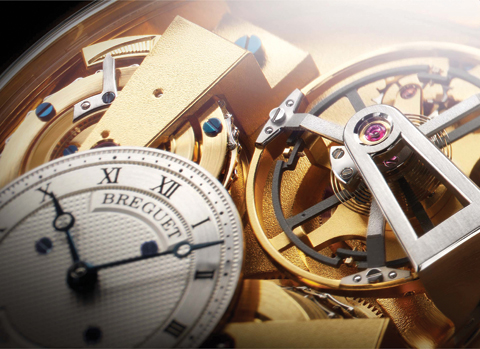Trois Tourbillons: Luxury Timepieces
Breguet, Vacheron Constantin, and Audemars Piguet

[highlight_text] leek and refined, the dial is crafted from 18-karat gold and offers five finishes: snailing, guillochage, opaline, vertical staining, and circular staining. [/highlight_text]
At more than 200 years old, tourbillon watches are still the most complex and most intriguing watches in the world. The history, technology, and quality that surrounds these time pieces are what sets them apart from the ubiquitous digital and less-involved analog displays of today.
In 1795, French watchmaker Abraham-Louis Breguet invented the tourbillon. His goal was to negate the effects of gravity in time keeping, which would help to attain a more accurate measurement of time. How he achieved this was by placing the watch’s balance wheel, escape lever, and escape wheel into a cage. This intricate innovation made complete rotation possible, which allowed for free movement, thus effacing the effects of gravity.
Although the proliferation of cell phones, smart phones, laptops, et cetera, has relegated these time pieces to their museum-quality status, manufacturers continue to improve the quality around the historic tourbillon apparatus.
Take the Breguet TRADITION 7047 Grande Complication ~ Fusée Tourbillon, for example. Positioned behind the off-centered dial, the complex fusée-chain pulley system controls the watch’s winding and unwinding, allowing for superior power and movement (569 caliber). The dial’s situation at the 35-minute mark is raised above a complicated background of mechanisms that are enclosed in a thin 18-karat yellow gold bezel.
Yet another tribute to the tourbillon is the Vacheron Constantin SIHH Malte Regulator Tourbillon. This presentation has the tourbillon in a tonneau shaped case that is characteristic of Vacheron Constantin’s Malte line. This shape had its heyday up until the 1940s, but has been included in the watch manufacturer’s collections since 1912. Today, the tonneau shape boasts platinum and pink gold cases. At 1790R caliber, the manual-winding movements comprise of the tourbillon, the regulator, and a power reserve indicator (40 hours). Sleek and refined, the dial is crafted from 18-karat gold and offers five finishes: snailing, guillochage, opaline, vertical staining, and circular staining. The Malte Tourbillon’s strap options feature dark blue or brown with complementing hand-stitching, saddle finishing, or square-scaled leather detailing.
Far surpassing both the Breguet and the Vacheron Constantin pieces is Audemars Piguet’s Royal Oak Carbon Concept Tourbillon and Chronograph. This black tourbillon piece is the first to combine carbon in its casing and movements. The lightweight, aviation-quality carbon case with 384-part caliber and 2895-movement, combines a tourbillon, a chronograph, and a twin-barrel power reserve system (237 hours). Turns for each barrel is restricted to an above-average 19.75 times. Situated below 12 o’clock is the power reserve indicator, an innovation that was first conceived by Audemars Piguet in 1885. At 6 o’clock, the H, N, and R lettering indicates the three positions of the winding stem, which are time-setting (H), neutral (N), and winding (R).
The bezel is crafted from Royal Oak’s signature ceramics and the surrounding case features eight titanium screws. The tourbillon carriage is composed of 70 parts that weigh less than half a gram.












